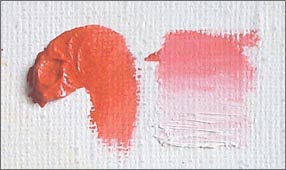
Origin, History and Characteristics
(Zinnober, cinnabar, cinnabar)
Vermilion is the standard name given to the red pigment based on artificially made mercuric sulfide. The common red crystalline form of mercuric sulfide is cinnabar (fig. 1), a name reserved only for the natural mineral. The natural product found chiefly in Almaden and Idria has been eliminated for practical purposes. The properties of both natural and artificially prepared are practically identical. The best cinnabar came from Spain, but there were deposits of it in Italy at Monte Amiata, not far from Siena, and elsewhere in Europe. Upon grinding the red color begins to appear, and the longer it is ground, the finer the color becomes. It was widely used in the art and decoration of Ancient Rome, in the illuminated manuscripts of the Middle Ages and in the paintings of the Renaissance. The color was most famously used in creating Chinese lacquerware, which was exported around the world, giving rise to the term "Chinese red."
The traditional use of red glazes of madder, kermes and cochineal lakes over vermilion underpaint (fig. 2) not only increases the purity of the color but has been shown to reduce the tendency to darken as well. It is also known that the farther light can penetrate into the binding medium, the more quickly the vermilion will darken.
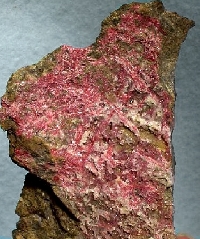
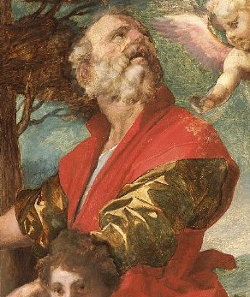
Andrea del Sarto
c. 1527
208 x 171cm.
Cleveland Museum of Art, Cleveland, Ohio
Detail of an unfinished drapery of the saint modeled in vermilion
Vermilion in Vermeer's Painting
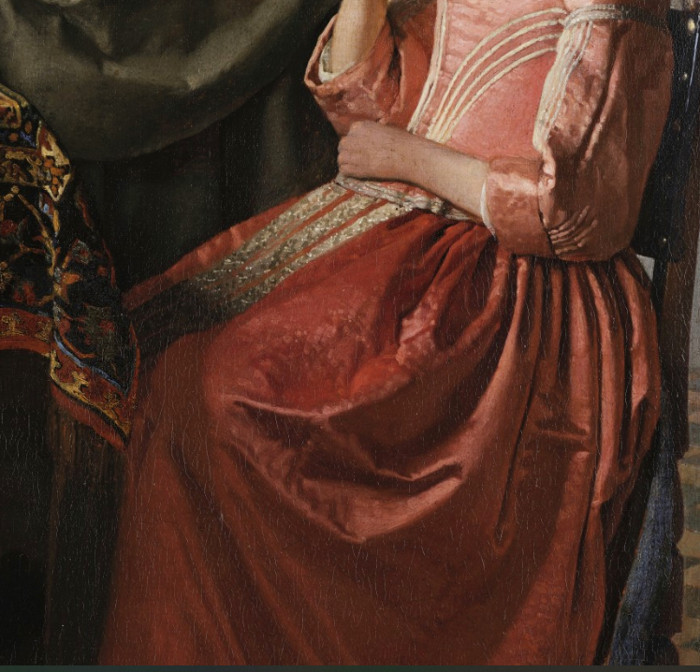
Johannes Vermeer
c. 1658–1661
Oil on canvas, 65 x 77 cm.
Staatliche Museen Preußischer Kulturbesitz,
Gemäldegalerie, Berlin
Vermeer used vermilion in the traditional manner under glazes. The striking red satin gown in the Glass of Wine and that of the Girl with a Wine Glass (fig. 3) were probably first modeled with shades of vermillion and white lead and perhaps small quantities of black or natural ultramarine in the deepest shades. The whole gown was then glazed with madder lake. The same technique was also used to paint the fanciful read plumed hat worn by the Girl with a Red Hat.
LOOKING OVER VERMEER'S SHOULDER
The complete book about Johannes Vermeer's and 17th-century fine-painting techniques and materials
by Jonathan Janson | 2020
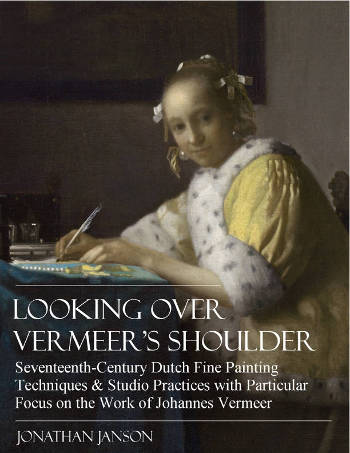
Enhanced by the author's dual expertise as both a seasoned painter and a renowned authority on Vermeer, Looking Over Vermeer's Shoulder offers an in-depth exploration of the artistic techniques and practices that elevated Vermeer to legendary status in the art world. The book meticulously delves into every aspect of 17th-century painting, from the initial canvas preparation to the details of underdrawing, underpainting, finishing touches, and glazing, as well as nuances in palette, brushwork, pigments, and compositional strategy. All of these facets are articulated in an accessible and lucid manner.
Furthermore, the book examines Vermeer's unique approach to various artistic elements and studio practices. These include his innovative use of the camera obscura, the intricacies of his studio setup, and his representation of his favorite motifs subjects, such as wall maps, floor tiles, and "pictures within pictures."
By observing closely the studio practices of Vermeer and his preeminent contemporaries, the reader will acquire a concrete understanding of 17th-century painting methods and materials and gain a fresh view of Vermeer's 35 masterworks, which reveal a seamless unity of craft and poetry.
While the book is not structured as a step-by-step instructional guide, it serves as an invaluable resource for realist painters seeking to enhance their own craft. The technical insights offered are highly adaptable, offering a wealth of knowledge that can be applied to a broad range of figurative painting styles.
LOOKING OVER VERMEER'S SHOULDER
author: Jonathan Janson
date: 2020 (second edition)
pages: 294
illustrations: 200-plus illustrations and diagrams
formats: PDF
$29.95
CONTENTS
- Vermeer's Training, Technical Background & Ambitions
- An Overview of Vermeer’s Technical & Stylistic Evolution
- Fame, Originality & Subject Matte
- Reality or Illusion: Did Vermeer’s Interiors ever Exist?
- Color
- Composition
- Mimesi & Illusionism
- Perspective
- Camera Obscura Vision
- Light & Modeling
- Studio
- Four Essential Motifs in Vermeer’s Oeuvre
- Drapery
- Painting Flesh
- Canvas
- Grounding
- “Inventing,” or Underdrawing
- “Dead-Coloring,” or Underpainting
- “Working-up,” or Finishing
- Glazing
- Mediums, Binders & Varnishes
- Paint Application & Consistency
- Pigments, Paints & Palettes
- Brushes & Brushwork
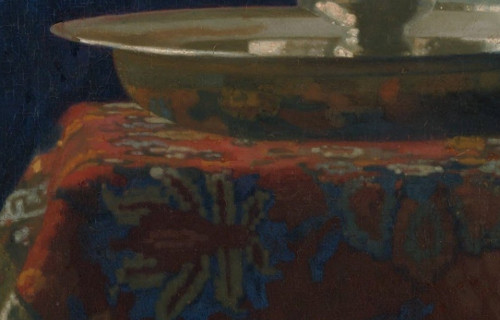
Johannes Vermeer
c. 1662–1665
Oil on canvas, 45.7 x 40.6 cm.
Metropolitan Museum of Art, New York
Vermeer also made use of vermilion to paint the oriental carpets (fig. 4 & 5) which appear on the tables in many of his interiors. Again he seems to have employed the same technique described above. In its purer form, vermilion may be observed in the various ribbons and trimmings worn by his sitters.
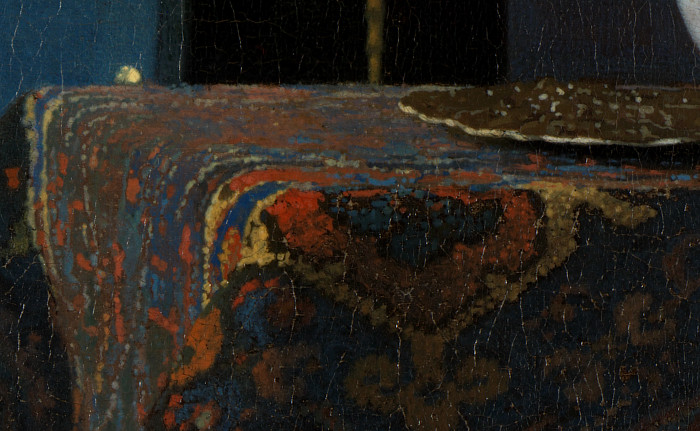
Johannes Vermeer
c. 1662–1665
Oil on canvas, 73.3 x 64.5 cm.
The Royal Collection, The Windsor Castle
